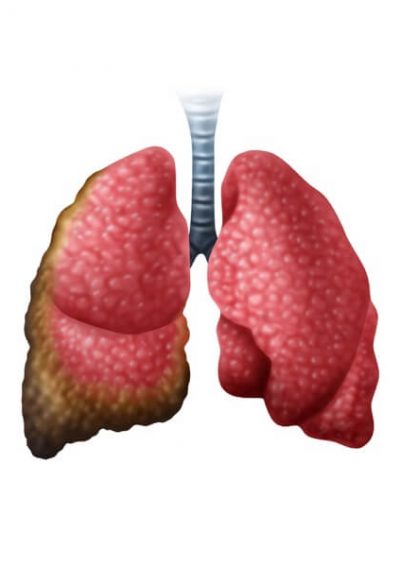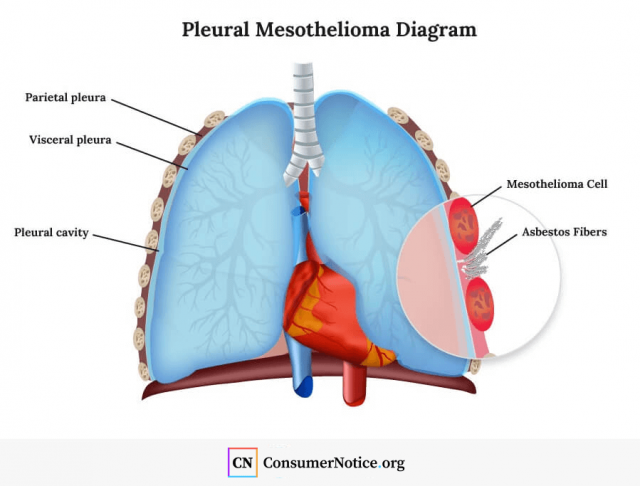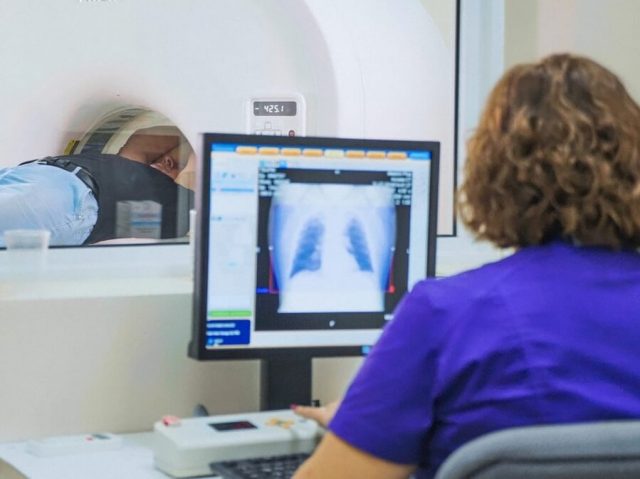Asbestos and Mesothelioma
Mesothelioma is a rare form of cancer caused primarily by asbestos exposure. The cancer may take decades to show up after exposure to asbestos, but once it does, the disease spreads quickly. The median survival time for people who have been diagnosed with mesothelioma is about 12 months, according to the American Thoracic Society.

Most people who develop mesothelioma have worked in jobs in which they breathed in asbestos fibers. The latency period, or the time that elapses between first exposure and diagnosis, may last 20 to 50 years after a person is first exposed to asbestos.
This type of cancer affects the pleural membranes in the body. These membranes line the chest and abdominal cavities. As many as four in five cases of malignant mesothelioma affect the membranes in the chest.
Cancer that develops in the lining of the lungs and chest cavities is called pleural mesothelioma. Doctors refer to cancer that forms on the abdominal lining as peritoneal mesothelioma.
Mesothelioma affects between 2,000 and 3,000 people a year in the United States. Several treatments and therapies exist, but there is no known cure. Once symptoms appear, the disease can quickly turn fatal.

How Does Asbestos Cause Mesothelioma?
Asbestos fibers are microscopic. When people breathe them in, the fibers travel to the very ends of small air passages in the lungs. From there, the fibers can reach the pleural membranes of the chest cavity. If they are swallowed, they can end up in the stomach or other internal organs and eventually reach the membranes lining the abdominal cavity.
Once asbestos fibers reach the membranes, they cause inflammation and scarring. This can trigger changes in a person’s DNA and cause uncontrolled cell growth, which can lead to cancer, including mesothelioma.
There is no ‘safe’ level of asbestos exposure for any type of asbestos fiber. Every occupational exposure to asbestos can cause injury of disease; every occupational exposure to asbestos contributes to the risk of getting an asbestos related disease.
Asbestos is the name for six different minerals that occur naturally in the environment. Not everyone who is exposed to asbestos will develop mesothelioma.
People who have worked in jobs with high amounts of exposure to asbestos for over a year or more are at the highest risk of developing the cancer. But just a few days exposure is enough to cause mesothelioma, according to the Occupational Safety and Health Administration.
“There is no ‘safe’ level of asbestos exposure for any type of asbestos fiber,” the agency said. “Every occupational exposure to asbestos can cause injury of disease; every occupational exposure to asbestos contributes to the risk of getting an asbestos related disease.”
People who were diagnosed can file a mesothelioma lawsuit against companies responsible for their asbestos exposure. Family members who have lost a loved one to the cancer can file wrongful death claims.
Symptoms and Diagnosis
While mesothelioma may not develop until decades after asbestos exposure, it is not a slow growing cancer. It may take years for asbestos fibers to cause the actual inflammation that breeds uncontrolled cell growth. But once that happens, mesothelioma grows aggressively, within months to years.
This can give patients a very narrow window to seek early treatment, and patients may not be aware of the cancer growing inside them.
General mesothelioma symptoms include:
- Blood clots
- Difficulty breathing
- Excess sweating
- Fatigue
- Fever
- Loss of appetite
- Pain beneath the ribcage
- Pain, swelling or lumps in the abdomen
- Unexplained weight loss
Diagnosing Mesothelioma
Mesothelioma can be hard to diagnose. And it may be difficult for doctors to tell mesothelioma apart from lung cancer at first. That means it may not be diagnosed until it’s in an advanced stage when it’s more difficult to treat. If you have worked around asbestos in the past, even decades ago, you should let your doctor know.
Diagnosis begins with your doctor reviewing your medical history and conducting a physical exam. Your doctor may also rely on blood tests to look for evidence of the disease. People with mesothelioma often have higher levels of certain substances in their blood. But a blood test alone cannot diagnose the disease.
If your doctor suspects mesothelioma, he or she may order digital imaging, such as CT or MRI scans. Depending on where in your body mesothelioma is suspected, the scan may focus on your lungs, heart or other parts of your body.

If these tests suggest the possibility of mesothelioma, the doctor may order a biopsy. This involves removing cells from areas that show abnormal growth inside the body. The samples will be reviewed under a microscope to look for evidence of the disease. Biopsies are the only way to accurately diagnose mesothelioma.
There are different ways doctors may conduct a biopsy. They may remove fluid they suspect built up because of mesothelioma, or they may use long needles to remove pieces of tumors they found in earlier tests.
A doctor may also use an endoscope, which is a thin tube with a light, a camera lens and surgical instruments attached to the end. It can be snaked through the body to look at possible tumors and remove pieces of them for testing. Or the doctor may surgically remove a tumor for testing.
Treatments and Therapies
Four types of treatment are standard for mesothelioma. Some may be used in combination with others to improve the chances of survival.
The four types of mesothelioma treatment are:
- Surgery
- A surgeon treating pleural mesothelioma, for example, may remove the cancer from the chest. This may include removing some healthy tissue around the cancer or tissue that covers the lungs and chest cavity. Other procedures may require removing one of the lungs. Another surgical procedure called pleurodesis drains fluid that has built up between the lungs and the pleura membrane lining the lungs. Then a surgeon fills the space with chemicals or drugs to create scar tissue. Patients undergoing surgery may also receive chemotherapy or radiation therapy later.
- Radiation Therapy
- A radiologist uses high-energy X-rays or other types of radiation to kill cancer cells and keep new ones from growing.
- Chemotherapy
- Patients who undergo chemotherapy rely on drugs to stop mesothelioma from spreading. Chemo either kills cancer cells or prevents them from multiplying. Patients can take some chemotherapy drugs by mouth. Others may be given through an injection into veins or muscles, or they may be injected directly into the chest or abdominal cavity.
- Targeted Therapy
- Targeted therapy generally causes less harm than radiation or chemotherapy. It uses drugs or other chemicals to target specific mesothelioma cells. Some types of targeted therapy use antibodies created in laboratories to attack and kill specific cancer cells. Other versions prevent new blood vessel growth around the tumor. Without new blood vessels, the tumors can’t grow.
Research into new therapies is also underway. If you have been diagnosed with mesothelioma, you may want to talk with your doctor about the pros and cons of taking part in a clinical trial. Most trials require that you have not already begun standard treatment before joining a trial.
Stages and Survival Rates
Average life expectancy from the time a person is diagnosed varies with age and overall health. It can be as little as one to five years for people who are older than 60 at the time of their diagnosis, according to a 2012 study in the Journal of Cellular Physiology.
The American Cancer Society uses a five-year relative survival rate to gauge average life expectancy after being diagnosed with mesothelioma. It compares people at different stages of the disease with those in the general population. Then, it calculates how likely each is to live for another five years.
American Cancer Society’s 5-Year Relative Survival Rates for Malignant Pleural Mesothelioma
| Stage | Definition | Relative Survival Rate |
|---|---|---|
| Localized | Mesothelioma is limited to the membranes of the chest. | 18% |
| Regional | Cancer has spread to nearby tissue or the lymph nodes. | 11% |
| Distant | It has spread to other organs, bones or to the membrane on the opposite side of the body. | 7% |
| Average survival rate for all stages of mesothelioma | 9% | |
For instance, if a particular stage shows an 18 percent five-year survival rate, then a person with that stage of mesothelioma is 18 percent as likely to live another five years as someone without the disease.
These numbers are not absolute. They can vary based on age, overall health, how well mesothelioma responds to treatment and other factors. As treatments improve, the rate of survival may also improve.
13 Cited Research Articles
Consumernotice.org adheres to the highest ethical standards for content production and references only credible sources of information, including government reports, interviews with experts, highly regarded nonprofit organizations, peer-reviewed journals, court records and academic organizations. You can learn more about our dedication to relevance, accuracy and transparency by reading our editorial policy.
- Agency for Toxic Substances & Disease Registry. (2016, August 9). Asbestos Toxicity; What Respiratory Conditions Are Associated with Asbestos? Retrieved from https://www.atsdr.cdc.gov/csem/csem.asp?csem=29&po=11
- American Cancer Society. (2018, November 2018). Signs and Symptoms of Mesothelioma. Retrieved from https://www.cancer.org/cancer/malignant-mesothelioma/detection-diagnosis-staging/signs-symptoms.html
- Carbone, M. et al. (2012, January). Malignant Mesothelioma: Facts, Myths and Hypotheses. Journal of Cellular Physiology. Retrieved from https://www.ncbi.nlm.nih.gov/pmc/articles/PMC3143206/
- Henley, S.J., et al. (2013, November 12). Mesothelioma Incidence in 50 States and the District of Columbia, United States, 2003-2008. International Journal of Occupational and Environmental Health. Retrieved from https://www.ncbi.nlm.nih.gov/pmc/articles/PMC4406225/
- Mazurek, J.M., et al. (2017, March 3). Malignant Mesothelioma Mortality – United States, 1999-2015. U.S. Centers for Disease Control and Prevention. Retrieved from https://www.cdc.gov/mmwr/volumes/66/wr/mm6608a3.htm
- National Cancer Institute. (2019, March 7). Malignant Mesothelioma Treatment (PDQ)-Patient Version. Retrieved from https://www.cancer.gov/types/mesothelioma/patient/mesothelioma-treatment-pdq#_130
- New York State Department of Health. (2015, May). About Mesothelioma. Retrieved from https://www.health.ny.gov/statistics/cancer/registry/abouts/malignant_mesothelioma.htm
- Noonan, C.W. (2017, June). Environmental Asbestos Exposure and Risk of Mesothelioma. Annals of Translational Medicine. Retrieved from https://www.ncbi.nlm.nih.gov/pmc/articles/PMC5497111/
- Ramazzini, C. (2016, March 31). The Global Health Dimensions of Asbestos and Asbestos-Related Diseases. Journal of Occupational Health. Retrieved from https://www.ncbi.nlm.nih.gov/pmc/articles/PMC5356970/
- ScienceDaily. (2009, August 25). New Technique Can Help Diagnose Mesothelioma. Retrieved from https://www.sciencedaily.com/releases/2009/08/090824081121.htm
- U.S. Centers for Disease Control and Prevention. (2016, October 26). Mesothelioma and the Environment. Retrieved from https://ephtracking.cdc.gov/showCancerMesotheliomaEnv.action
- U.S. Department of Labor. (n.d.). Asbestos. Occupational Safety and Health Administration. Retrieved form https://www.osha.gov/asbestos
- U.S. National Library of Medicine. (2019, March 19). Mesothelioma; Also Called: Malignant Mesothelioma. Medline Plus. Retrieved from https://medlineplus.gov/mesothelioma.html
Calling this number connects you with a Consumer Notice, LLC representative. We will direct you to one of our trusted legal partners for a free case review.
Consumer Notice, LLC's trusted legal partners support the organization's mission to keep people safe from dangerous drugs and medical devices. For more information, visit our partners page.
855-828-7574
